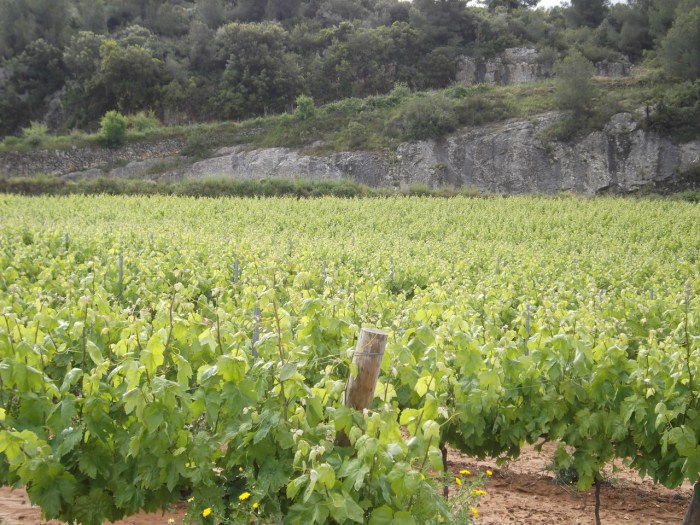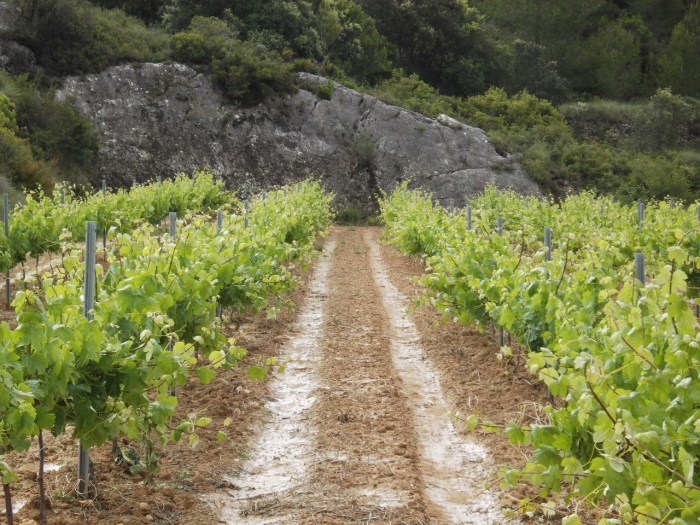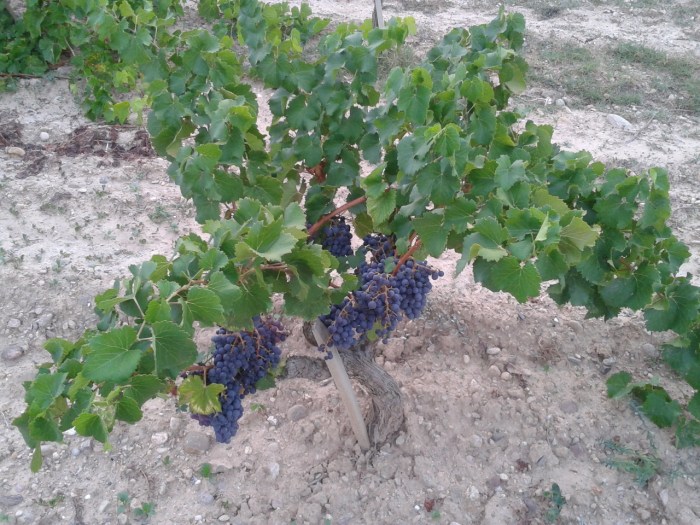Number 16 is just a house. It sits at the end of a paved street, just across from a patch of gnarled vines, the only hint that I’ve arrived at a vineyard. In fact, I’ve toured the two-street town twice already searching for it. I’m here for the tour of Foresta, a small winery tucked away in the tiny village of L’Arboçar, which sits deep in the heart of Catalunya’s wine-making region, D.O. Penedès, midway between the mountains and the sea. Like the town it sits in, it’s a micro-operation indeed. A few French oak barrels and two small steel fermentation tanks are housed in the garage, and there’s a small artichoke patch around back. It’s not what you’d expect of a vineyard, but in a region of small production, family-owned vineyards, it’s not unusual either.
There’s just three of us out in the fields braving the chilly weather today: wine making partners Joan Olivella and Lluís Carsí and me. They’re taking me to the top of their steeply terraced vineyard to admire the view, but also so we can talk about the weather. It’s important here, especially in this zone dotted with microclimates. We pile into their dusty work truck and launch off the residential street onto a narrow path of pale orange clay, up and away from the tiny pastel town. We bump along blowing up dust all around us, shocks creaking, snaking up the rock-strewn dirt road past small plots of still-bare vines. Along the way, we pass a mountain biker pedaling steadily upwards, braving the uneven ground.

It’s not yet spring, a fact signaled by the blustery wind from the Mediterranean Sea that whips around us as we hike the narrow ridge that runs above the vineyard. The vines are bare, with nothing to show but shaggy bark and the carpet of white flowers that bloom around their base each spring. Nevertheless there’s a silent process at work, and soon the vines will sprout tender buttons of bright green leaves, soon to unfurl in the warming weather. Today is not a normal day, they tell me. Normally the breeze that blows rolls across the terraced hills is warm and humid, bringing steady relief to the vines from the baking heat of summer days. To the west spreads the low, flat land of Penedès, where the vineyards are divided into neat quadrants, soaking up the warm Spanish sun. To the east is the sea, and before it the land of the Massís del Garraf, a tiny zone of microclimates and terraced land which slopes gently toward the water.
Lluís is searching for a rock to show me, a fossil actually, one that has the age-old record of marine life inscribed upon it. They are common in this area, where the sandy, clay-like soil is mostly composed of limestone, which forms an integral part of the wine’s terroir. It’s what distinguishes it from, say, the wines of Priorat where the shale-heavy soil is marked by a different sort of minerality. The soil in Penedès is just one of the elements which helps to make it one of the best wine-producing regions in Spain after Rioja.

The hilltop is covered in rugged shrubs of wild rosemary and thyme dotted with pale purple blooms. Its fragrance reaches up each time our legs brush against it as we make our way carefully along the narrow, rocky path. When we reach the end, we are greeted by two low cement posts that will form the base of the table they’re building. Soon, they tell me, guests will be able to sit here and taste their wines while taking in the stellar views. It’s a seductive one to be sure, with the Mediterranean shimmering in the distance, and the patchwork of vines lacing the countryside that meets it.
Yet what we might appreciate as a serene, softly rolling landscape, they view as labor, each narrow terrace a careful negotiation of manual labor and careful footwork by family members and hired workers. From vine to bottle, the wine production demands a complex calculation involving orientation, sun exposure, moisture, and physical collection. It’s one that Joan was taught by his father and his father before him. It’s one he’s learned by trial and error. It’s not a perfect science, but it’s his and somehow that’s enough.

Despite its challenges, they love this land they work. They love its thick green forests, which inspired their name, because they protect their organic vines from potential contamination from other vineyards. They also love the fauna that inhabits them, like the wily little fox, a common sight in the Garraf, that dances across their label. They don’t love the wild boars quite as much– javelís in local parlance–which are far less fleet-footed and far more destructive to the vines. One ate his way through almost 15,000 grapes from a neighbor’s vines in one night. They’re now kept out by an electric fence.
Together they make only three wines, one white and two reds, although a dessert wine, a Viognier, is on the horizon. Their wines are carefully crafted from mostly local varietals, each a labor of love. Foresta’s wines are made almost exclusively from local grapes, Xarello (the x is pronounced softly like a ‘sh’), Sumoll, and Marselan (a cross between Grenache and Cabernet Sauvignon), a relatively new grape that only arrived in Catalunya from coastal France in 1990. It’s admired for being disease resistant, but its small fruit and low yield make it a challenge to work with.

Xarello, a white grape used in cava, makes an aromatic white. Although their Xarello has a bit of Viognier thrown in, it’s still a monovarietal wine. Yet, monovarietals aren’t necessarily simplistic. To create maximum expression, they harvest the Xarello grapes from three different parcels with different orientations and soil compositions in order to create a more interesting “blend,” even though they’re all the same grape. Foresta’s is lemon-like and heady with the scent of lime blossoms. You can taste a mineral kiss of limestone, but mostly you can taste the salt of the sea.
Their Sumoll has a subtle floral aroma of violets and rose petals on the nose but the body is light like a Pinot Noir. In this one, too, the minerality of the soil comes through. Sumoll comes from a slang term in Catalan, sumollar, which refers to the maturing, literally withering, that takes place when grapes become raisins. It’s a grape native to Catalunya but one that isn’t widely planted. It’s also a grape that takes time and energy to do right. The long, big fruit needs a highly skilled winemaker to bring forth its best qualities. Paired with low yields, it’s a grape that most winemakers don’t take the time to invest in. Indeed, Foresta is one of the few wineries that’s helping to bring this grape back into view.

Unlike large production wineries with wide distribution, they don’t make much money, but it’s enough to get by. Eventually, they hope to buy more land so that they can expand production and new equipment to help them harvest faster and more efficiently. In the meantime, they’re thinking of new ways they can share their love of the land with guests. They’ve converted three old stone huts on the property, originally used by field workers to protect them from storms, into sweetly decorated single room eco-huts where guests can stay in a private patch of land in the middle of the vineyard. They’re beautifully rustic little spaces, covered with a profusion of wild irises for drainage, which open up to incredible views of the vines and forest, offering just what one would need to disconnect and relax.
When we finally arrive back in the garage, Lluís shows me their modest setup: the couple small stainless steel fermenting tanks and six small oak barrels. A shelf on the wall holds a few bottles of their latest wines. He opens a Xarello from 2015 so I can taste it, while I press him about what motivates him to make wine. The work is hard, the challenges sometimes daunting, he tells me, but the joy is simple. What makes him most happy, he says, is seeing his guests enjoy what they drink. Just that.

Never spill a drop with the Avina Wine Tools Bottle Stopper. For more information, click here.
To schedule a visit: Vins de Foresta
Website: http://www.vinsdeforesta.cat/
Phone: +619 00 88 38
About the author: Melissa Leighty is freelance writer and photographer based in Barcelona, Spain. When she’s not writing about wine, she covers travel and food for Metropolitan and Miniguide and is at work on her first cookbook about Catalan cuisine. Visit her at www.melissaleighty.com and follow her latest culinary adventures on her food blog, Ataula. She’s on Instagram as well @mpleighty and @ataula_co.
